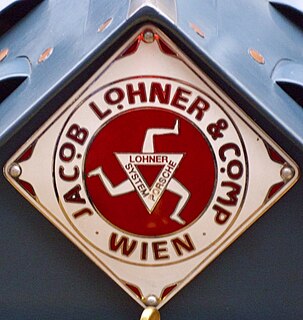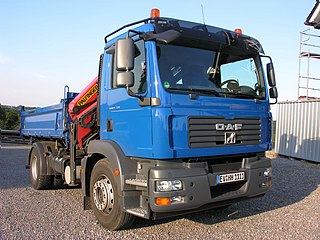Related Research Articles

Ferdinand Porsche was a German Bohemian automotive engineer and founder of the Porsche car company. He is best known for creating the first gasoline-electric hybrid vehicle (Lohner-Porsche), the Volkswagen Beetle, the Auto Union racing car, the Mercedes-Benz SS/SSK, several other important developments and Porsche automobiles.
Rotax is the brand name for a range of internal combustion engines developed and manufactured by the Austrian company BRP-Rotax GmbH & Co KG, in turn owned by the Canadian Bombardier Recreational Products.
Eugen Sänger was an Austrian aerospace engineer best known for his contributions to lifting body and ramjet technology.

Innocenti was an Italian machinery works, originally established by Ferdinando Innocenti in 1920. Over the years, they produced Lambretta scooters as well as a range of automobiles, mainly of British Leyland origins. The brand was retired in 1996, six years after being acquired by Fiat.
The Austrian resistance launched in response to the rise in fascism across Europe and, more specifically, to the Anschluss in 1938 and resulting occupation of Austria by Germany.

Helmuth Lohner was an Austrian actor, theatre director, and from 1997 to 2006 director of the Theater in der Josefstadt.

Fritz Löhner-Beda, born Bedřich Löwy, was an Austrian librettist, lyricist and writer. Once nearly forgotten, many of his songs and tunes remain popular today. He was murdered in Auschwitz III Monowitz concentration camp.

Gräf & Stift was an Austrian manufacturer of automobiles, trucks, buses and trolleybuses, from 1902 until 2001, latterly as a subsidiary of MAN. Founded in 1902 by the brothers Franz, Heinrich and Karl Gräf, and the investor, Wilhelm Stift. Before the Second World War, the company was a well-known manufacturer of luxury automobiles, including the Double Phaeton that carried Archduke Franz Ferdinand and his wife, Sophie, when they were assassinated in Sarajevo in June 1914. By the 1930s Gräf & Stift had begun making trucks and buses, and it ceased car manufacturing in 1938. The company merged with Österreichische Automobil Fabriks-AG (ÖAF) in 1971, becoming ÖAF-Gräf & Stift AG, and later the same year was taken over by MAN AG. It continued in business as a subsidiary of MAN, and the Gräf & Stift name remained in use as a MAN brand for the Austrian market and for trolleybuses until 2001, when ÖAF-Gräf & Stift AG was renamed MAN Sonderfahrzeuge AG. It was located in Vienna, and the production facilities continue in use there, but no longer using the Gräf & Stift name.

Julius Arigi was a flying ace of the Austro-Hungarian Empire in World War I with a total of 32 credited victories. He was Austro-Hungary's most highly decorated ace. His victory total was second only to Godwin von Brumowski. Arigi was considered a superb natural pilot. He was also a technical innovator responsible for engineering changes in the aircraft he flew.

The Lohner–Porsche Mixed Hybrid was the first gasoline-electric hybrid vehicle, and was developed by Ferdinand Porsche at Lohner-Werke. First prototypes were two-wheel drive, battery-powered electric vehicles with two front-wheel hub-mounted motors. A later version was a series hybrid using hub-mounted electric motors in each wheel, powered by batteries and a gasoline-engine generator.

Gottfried Freiherr von Banfield was the most successful Austro-Hungarian naval aeroplane pilot in the First World War. He was known as the 'Eagle of Trieste' and was the last person in history to wear the Military Order of Maria Theresa. He scored 9 aerial victories during the war, making him one of the only Flying aces who flew a flying boat to five or more victories.

Lohner-Werke or simply Lohner, was a Viennese luxury coachbuilding firm founded in the 19th century by Jacob Lohner.

Friedrich Maria "Fritz" Tarbuk von Sensenhorst, aka Friedrich Maria von Tarbuk-Sensenhorst was a lieutenant in the Imperial Austro-Hungarian Navy and captain in the Army, as well as an entrepreneur/businessman, one of the most important businesses in the motor trade in Austria and CEE until the beginning of the 21st century.

ÖAF is an initialism for Österreichische Automobil-Fabrik, previously known as Österreichische Austro-Fiat, an Austrian (Austro-Hungarian) car and truck manufacturer that now is completely incorporated into MAN.

Alfred Comte was a Swiss aviation pioneer. He was active as a pilot, photographer, instructor, also as one of the first aviation entrepreneurs and was successful in the construction of civilian and military aircraft.

The Blohm & Voss P.208 was a design project for a tailless swept-wing propeller-powered interceptor designed by the German company Blohm & Voss towards the end of the Second World War.

The Škoda-Kauba SK P14 was a ramjet-powered emergency fighter project for the Luftwaffe. It was designed by the Škoda-Kauba industries towards the end of World War II as part of the Third Reich defense effort against the devastating allied bombing raids.
Ludwig Lohner ran his family's company as it became one of the first manufacturers of cars and airplanes in Austria-Hungary.
The Škoda-Kauba Flugzeugbau was a Czechoslovakian aircraft manufacturer, formed during World War II as a joint venture between Otto Kauba and the Škoda Works. Kauba produced a number of innovative designs and the company built several prototypes, with the SK 257 fighter-trainer entering limited production before being cancelled. The company ceased to exist at the end of the war.
References
Citations
- 1 2 3 4 5 Saffek & Plocek (1992).
- 1 2 Otto Kauba, Find A Grave. (retrieved 7 May 2019)
- ↑ Titz & Zazvonil (1965).
- ↑ Rudolf Santner (1994), Österreichische Motorräder und Beiwagen: 1918-1960 (in German), Weishaupt Verlag, p. 77, ISBN 9783705900103,
Nach dem Zweiten Weltkrieg begann Lohner 1949 mit der Herstellung von Rollern nach Plänen und unter der Leitung von Ing. Otto Kauba. Dieser von einem Rotax- Motor (Lizenz Sachs) eher mäßig schnell fortbewegte Roller war ab 1950 käuflich..
- ↑ Branko Remek (2012), Automobil a spalovací motor (in Czech), Grada Publishing a.s., Lohner, p.60, ISBN 9788024735382
- ↑ Kurt Bauer (2003), Faszination des Fahrens: unterwegs mit Fahrrad, Motorrad und Automobil (in German), Böhlau Verlag Wien, Kleine Enzyklopädie des Fahrens, "Lohner", pp.250-1, ISBN 9783205770978
- ↑ Franz Straka (December 2007), "Ära Lohner : Von der Kutsche bis zur Motorisierung", www.strassenbahn-europa.at (in German), Railway Media Group
- ↑ Kosty (A), Fahrzeug-Archiv, GTÜ Classic. (In German) (Retrieved 23 July 2019)
- ↑ Lux, Virtuelles Kraftfahrzeug Museum Austria (VKMA), (Virtual Motor Museum Austria). (In German) (retrieved 22 July 2019)
- ↑ Sheldon's EMU; Lux Motor Scooters.
- ↑ "Did You Know...?", Air Pictorial, Vol. XVIII, No. 8, August 1956, p.285.
- ↑ Gunston, Bill; World Encyclopedia of Aircraft Manufacturers, 2nd ed, Sutton (2005), p.345.
- ↑ "Air Intelligence: Austria". Flight : 73. 18 January 1957. Retrieved 6 January 2019.
Bibliography
- Saffek, Otta and Plocek, Pierre; "Les Étranges Créations d'Otto Kauba", Le Fana de l'Aviation, No.272, July 1992, pp. 14–22. (in French)
- Titz, Zdenek and Zazvonil, Jaroslav; "Kauba's Dwarfs", Flying Review International, November 1965, pp. 169–172.